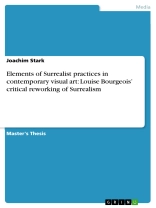Master’s Thesis from the year 2008 in the subject Art – Sculpture / Plastics, grade: distinction, The Open University (Department of Art History), language: English, abstract: This research project wants to assess to what extent Louise Bourgeois is employing Surrealist practices in her work. Another question is in what way Bourgeois criticized the practices of historical Surrealism and how she has developed these practices further in order to adapt them to new subject matter, for instance feminist themes.
Chapter I tries to elucidate, how art historians and art critics since the 1980s referred to Surrealism when interpreting Bourgeois’ work. It is possible to show that Bourgeois used the concept of the “Surrealist object” for her installations. However, she did this in a way in which the female body is only present by implication. The erotic dimension, which was of great importance for the Surrealists, is destroyed by allusions to old age and death. Bourgeois’ installations of the 1990s can therefore be considered as a radical and feminist reuse of the surrealist object.
Chapter II looks at works which imply allusions to the unconscious and psycho-analysis, like the installations Arch of Hysteria (1992/3) and Precious Liquids (1992). Here I also take into account Bourgeois’ own comments on her work. Although artist’s comments do not represent a definitive interpretation of a work of art, this aspect seems justified as Bourgeois claims that her art is the result of her direct access to her unconscious. At least according to Freud this direct access is impossible, the unconscious being something impenetrable, which communicates with the conscious only by signs. However, in her installations Bourgeois consistently makes allusions to the erotic and desire, but she also shows their reverse side: fear, pain, violence, voyeurism, ephemerality, and the ambiguities of male and female identity.
Chapter III looks at the overall social context of the 1960s and 1970s, to which Bourgeois responded with her art, for instance by supporting the Women’s Liberation movement. It seems likely that the story of her personal traumatic experiences as a young girl in France was motivated so late in life by changes in the art world, where Modernism had lost its impact and where art again should deal with content and the biographical.
Conclusion: Louise Bourgeois uses the aspects of emancipation and critique inherent in historical Surrealism, in order to criticize the patriarchal aspects of Surrealism. At the same time she develops Surrealist practices further in order to deal with new subject matter, like feminism, the body, and emotional violence.
Joachim Stark
Elements of Surrealist practices in contemporary visual art: Louise Bourgeois’ critical reworking of Surrealism [PDF ebook]
Elements of Surrealist practices in contemporary visual art: Louise Bourgeois’ critical reworking of Surrealism [PDF ebook]
¡Compre este libro electrónico y obtenga 1 más GRATIS!
Idioma Inglés ● Formato PDF ● Páginas 63 ● ISBN 9783640651351 ● Tamaño de archivo 8.2 MB ● Editorial GRIN Verlag ● Ciudad München ● País DE ● Publicado 2010 ● Edición 1 ● Descargable 24 meses ● Divisa EUR ● ID 3890094 ● Protección de copia sin












